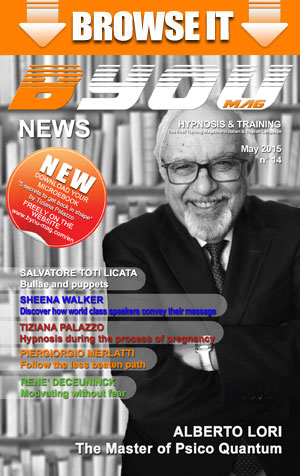The Archaic Chain: hypnosis is a intimate relationship by Marco Pacori
30 May, 2014
 The most common conception of hypnosis explains the development of this phenomenon in relation to a discretion of the individual: on the basis of this assumption, people can have a high, medium or low response to hypnosis. The degree of hypnotisability however, is not invariable: in a study, Individuals subjected to sensory deprivation (to lie in the dark and soundproof rooms) increased significantly response to hypnotic suggestions. In addition, investigations on the ability to resist to the hypnotic suggestions have revealed that even those with a high receptivity may be reticent if there is less confidence in hypnotist. Last but not least, many experts have reported anecdotes of hypnosis in which they cited as the subject can react to changes in the minimum (and often unintended ) of the hypnotist as the fact that slip him the pen by hand, which he hit, moving his self, the edge of the desk or an object, perhaps physically moving away from the subject. Even more important is the observation of Hungarypsychologists Éva I. Bányai, and István Mészáros László Csókay whose have observed that over the course of several experiments that muscle activity hypnotic of hypnotist and of the subject change simultaneously.
The most common conception of hypnosis explains the development of this phenomenon in relation to a discretion of the individual: on the basis of this assumption, people can have a high, medium or low response to hypnosis. The degree of hypnotisability however, is not invariable: in a study, Individuals subjected to sensory deprivation (to lie in the dark and soundproof rooms) increased significantly response to hypnotic suggestions. In addition, investigations on the ability to resist to the hypnotic suggestions have revealed that even those with a high receptivity may be reticent if there is less confidence in hypnotist. Last but not least, many experts have reported anecdotes of hypnosis in which they cited as the subject can react to changes in the minimum (and often unintended ) of the hypnotist as the fact that slip him the pen by hand, which he hit, moving his self, the edge of the desk or an object, perhaps physically moving away from the subject. Even more important is the observation of Hungarypsychologists Éva I. Bányai, and István Mészáros László Csókay whose have observed that over the course of several experiments that muscle activity hypnotic of hypnotist and of the subject change simultaneously.
These findings led to the hypothesis that, under certain conditions, attention to the hypnotist’s behavior on the part of those who are hypnotized can grow considerably and that this affects the outcome and effectiveness of hypnosis suggestions. As a result, the focus of research has shifted to the quality and type of relationship between operator and hypnotic subject, proving that a different way of doing of the first conditions deeply what happens during hypnosis. In this regard, the most significant studies derive to us by psychologists Katalin Varga, Éva I. Bányai that together with other colleagues have identified two different styles in inducing hypnosis: a way of doing maternal called” organic physical involvement and a paternal attitude, called “analytic – cognitive” proving that not only are different, but above all lead to different results. The physical-organic involvement is characterized by a deep empathy for the subject by the hypnotist, manifested by a reflection of the postures of the second, by simultaneous movements, from the synchronicity of the frequency of breathing, a frequent eye contact and physical proximity.
The analytic-cognitive attitude is characterized by a way of doing it more cold, aseptic and detached; in some cases, it is noticed that this way of doing inhibits the subject whom during the interview that precedes hypnosis tends to be little chatty and speak less of his self.
To test whether these different attitudes have a weight in the result of hypnosis; the Romanian scholars have made some hypnotic sessions with the two styles to a group of subjects with different degrees of susceptibility to hypnosis. To verify the impact they were based, not only on the reports of the subjects, but they have applied the electrodes both to the latter, and to hypnotists; electrodes were connected to equipment that recorded the EMG (electromyogram – muscle tension), ECG (electrocardiogram) and EEG (electroencephalogram). They have thus established that when the hypnotist showed a great interest (maternal attitude) in relation to the subject, it was recorded a tension in the same muscle groups in both. But the most surprising outcome has been the analysis of electroencephalographic tracings: although in a different way, the two synchronized alterations of brain waves! This study has demonstrated that the phenomenon known as “interactive synchrony” (ie, a coordination between two individuals) even before on the behavioral plan, is observed at the physiological level. On a personal level, the subjects developed a sense of ownership and merger with the hypnotist and produced marked changes in the state of consciousness as well as to implement the suggestions given by the first in a very “heard” (and observable). In conclusion, if the operator is able to synchronize with the hypnotic rhythms and the behavior of the subject, he recreates the symbiotic relationship that characterizes the first form of bond between infant and mother.
Marco Pacori
Related Posts
-

Hypnosis repairs the brain by Marco Pacori
-

The Emotional Intelligence Goes On Holiday by Silvia Minguzzi
-

Mental Sport Coaching by Salvatore Toti Licata
-

Bryan Smith' Quotes by Bryan Smith
-

ThatConnect MUSIC by Clinton Bishop
-

More than Jazz ... di Tal Babitzky
-

How to Stay Young By Camelia Cicu
-

The Violence in Relationship by Antonietta Paglia
-

E.R.T. and D.N.A. in correlation, the change of ancient memory by Tiziana Palazzo
-

Outdoor training and emotions by Silvia Minguzzi



